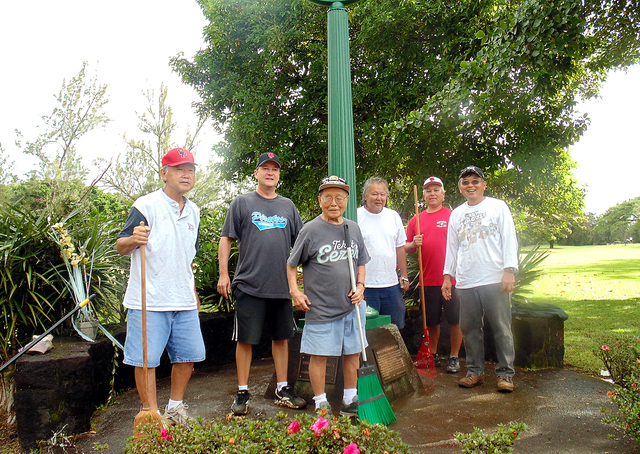The tall green clock at the edge of Banyan Golf Course stopped at 1:04 in the morning on May 23, 1960. Its gears don’t move anymore, but the clock keeps time in a different way. It’s now a monument commemorating
The tall green clock at the edge of Banyan Golf Course stopped at 1:04 in the morning on May 23, 1960. Its gears don’t move anymore, but the clock keeps time in a different way. It’s now a monument commemorating the lives of those lost the day the clock stopped, when a tsunami swept through Hilo, killing 61 people, leveling homes and shops, and destroying the waterfront area.
On Saturday, the Waiakea Pirates Athletic Club will hold a memorial service at the clock in honor of the 55th anniversary of the 1960 tsunami. The event begins at 10 a.m. and continues at 10:30 with a lunch at Coqui’s Diner. Gloria Kobayashi, co-author of The Yashijima Story, a history of the club, will speak at the lunch.
The athletics club was first organized in 1924 with the goal of encouraging local kids to participate in sports and in their community. After the tsunami, its members added another aim.
“They’ve taken the role as stewards of the clock,” said George Yoshida, one of the event organizers. Yoshida’s son played for the athletics club as a boy.
Yoshida himself was a sophomore at Hilo High when the tsunami hit.
His father worked in one of the shops in Waiakea, the area hit hardest by the disaster.
Yoshida remembers going outside to catch a school bus the morning after. The bus never came.
“We all got assigned to help the merchants clean up the shops,” Yoshida said. “We didn’t have class for quite a while, [but] within the next month school was over anyway.”
The clock was thrown on a scrap heap near the golf course’s maintenance shed, but athletics club members brought the timepiece out and turned it into a monument.
These days, they clean up the clock’s rust spots, keep the plants around it healthy, and place flowers at its base every week.
For decades, this effort has been led by Takayoshi Kanda, who is now 97. Kanda lost his father during the tsunami.
Names of the men and women who died during the disaster will be read aloud during Saturday’s ceremony.
The 50th anniversary of the tsunami was marked by a much more involved program, which featured a makeshift Waiakea Town built inside the civic auditorium.
Though Saturday’s event is smaller, the memorials remain a way to keep people involved in Hilo’s history.
“There are still some families around,” Yoshida said. “They may not live in the same area, but they are still around.”
Email Ivy Ashe at iashe@hawaiitribune-herald.com



